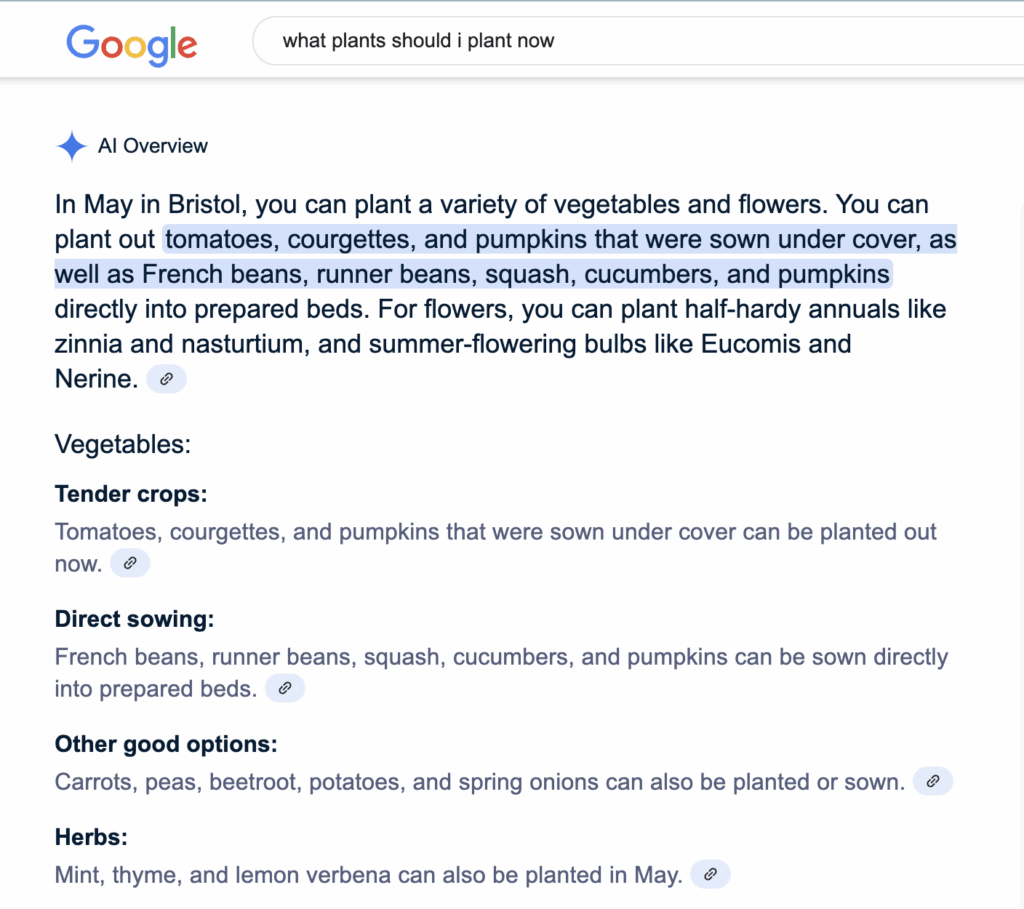In May 2024, Google launched AI overviews (AIO), rolling them out for all users throughout the rest of the year. A familiar sight in search results ever since, the increased prevalence of AI overviews is transforming how we search, filter through information sources and discover brands online.
This piece offers a deep dive into how AI overviews work, the ways they’re impacting SEO and how to achieve visibility for your brand. We break down your questions surrounding overviews and try to discern what their presence means for businesses and brands attempting to reach audiences through organic optimisation.

How do AI overviews work?
AI overviews are a SERP feature that aims to provide users with clear, AI-generated answers to everyday queries. As opposed to other SERP features such as People also Ask, they typically sit at the top of Google search results, aiming to provide an immediate answer to informational queries.
These overviews pull together content from multiple web sources and collates them into concise summaries, including links to these sources. This benefits the user by providing a ‘no-click’ answer to their question, eliminating the need for them to click through to a page or scroll further down the results.
The impact of AI overviews on search
In a very short space of time, AI overviews have had a disruptive and meaningful impact on search behaviour. They’ve reshared how organic success is defined and forced marketers across paid and SEO disciplines to re-evaluate their approach to measuring visibility.
The rise of AIOs has accelerated ‘zero click’ search results. This has resulted in traffic losses across informational terms. However, some businesses might also see increases in click through rates if users click through a link featured in an overview. In what represents a significant change in organic performance measurement, a first-place ranking doesn’t necessarily mean guaranteed success. A first place ranking might look great in reports but if it’s pushed down by ads, PAAs and other features users may not even see your listing.
That’s not to say AI overviews have had a solely negative impact on SEO. They’ve changed user behaviour, but perhaps for the better. For every AI hallucination and bizarrely-hilarious misinterpretation of context, AI overviews have also elevated a brand beyond their organic potential, helping them to leapfrog first place competitors. AIOs have reframed what it means to “rank” on search engines. The traditional first position is now directly competing with an array of SERP features, from AI overviews to People Also Ask to paid advertising. In some cases, targeting AI overviews might be the best strategy for achieving quick visibility.
AI overviews are more than a search feature, they’re a signal — one that users want faster answers and clarity on SERPs, but also authenticity. The takeaway? AI has and will continue to change the search landscape, but all signs point to a prioritisation of brands that lead with substance, not shortcuts.
The positives and negatives of Google AI overviews
Are AI overviews a beneficial addition to Google? That’s a complicated question.
Its undeniable AI overviews offer users a streamlined version of the search experience, but that doesn’t always ensure the most valuable (or accurate) one. While still clearly a developing SERP feature, there are costs and benefits for both users and marketers when it comes to investing in optimising for overviews.
THE BENEFITS OF AIOS
- A fast, user-friendly search experience: AI overviews take complex, dense queries and condense them into easily digestible summaries, highlighted and typically formatted with bullet points to make them scannable. This reduces the amount of time users spend navigating multiple sources, streamlining the search journey and freeing up more time.
- Enhanced brand visibility: Brands featured in AI overviews benefit from top-of-SERP placement. In most cases, this includes appearing above traditional organic listings and high authority sites. This elevated positioning sends vital trust signals and enhances a brand’s reputation.
- A favourable view of user-first content: Experimentation with AIOs suggests Google prioritises content that’s clear, well-structured and answers user questions directly. Brands already focused on high-quality, human-centred writing could well find themselves strongly positioned to surface in summaries, suggesting an enhanced importance on writing for users over search engines.
- An opportunity to showcase your expertise: EEAT signals are the difference maker when it comes to overviews. Brands that consistently produce concise, informative content based on a deep understanding of their subject matter or first-hand experience are more likely to see themselves featured. The mosret trustworthy you are, the higher you appear in AIOs.
The challenges of AIOs
- Reduced click through rates and typical visibility: When an AI overview directly answers a user’s query, there may be no further incentive for them to keep scrolling, leading to reduced visibility and fewer clicks for pages appearing as organic results or underlying sources (even if your content informed the summary). This is particularly an issue on mobile devices, where AIOs take up a significant portion of the screen.
- Accuracy and trust concerns: Questions of accuracy have plagued AI innovations since LLMs first went mainstream. AI-generated summaries are not always reliable, with some high profile AIO mistakes and AI “hallucinations” underlining how the technology can misinterpret content, struggle to differentiate satire from fact and integrate opinion-based content where it isn’t relevant. This poses risks in sensitive industries such as healthcare, finance and legal.
- Oversimplification and content dilution: Likewise, in an effort to generalise and provide the most succinct answer, AI may flatten complex topics into basic summaries, misrepresenting nuanced arguments or omitting key details. This poses the risk of undermining specialist content or diluting a brand by cherry picking out-of-context content or placing it alongside less authoritative competitors.
- Increased SERP competition: In an effort to provide the most thorough answer to informational queries, AI overviews pull from a wide range of sources. This can include competitors, forums and social platforms, creating more competition for space and attention, with sometimes 7-8 sources appearing for each overview.
- AI scepticism: For users wary of AI’s accuracy, the increased presence of features such as AI overviews may push them away from traditional search engines and towards alternatives such as Reddit or TikTok.
How CAn we optimise for AI overviews?
While, as yet, there’s no definitive formula that’ll guarantee your page’s appearance in an AI overview, we’re beginning to notice clear similarities across featured content. Optimising for AI overviews is less a case of reinventing the wheel or radically altering your approach to content, but rather adapting how you present and support that content. One emerging development to pay attention to is how AI analyses copy for structures and relevancy signals. The content chosen for AI overviews consistently answers questions directly. It summarises the point and aims to answer the question immediately, adding additional content further down the page, rather than burying it under keyword-stuffed pre amble.
It’s important to consider the ways to encapsulate the fullest answer to a query while predicting any follow up questions users might have. As Google says, great content is about following SEO and writing for the web best practice — that means clear headers in a logical structure and creative formatting that makes the piece scannable.
“AI overviews are user focused, so there isn’t a way to cheat the system to get your page into the AI overviews. Simply put, create content that is user first, and follows the guidelines of EEAT. A website with a breadth of content demonstrating EEAT in a particular topic, will be more likely to appear for any new SERP features, such as AI overviews.” – Jack McGivern
There’s also an undeniabley importance put on topical authority. AI doesn’t just lift answer snippets in isolation, it assesses how often your domain speaks on a topic, the consistency of your coverage and how related content is weaved together. Send positive EEAT (Experience, Expertise, Authoritativeness and Trustworthiness) signals and be a reliable source for your users before you start thinking about attracting new ones.
The answer for consistent presence on AI overviews lies somewhere between thorough content ecosystems and making your credentials and experience clear across your site; about us pages, author profiles, positive reviews and an active social presence.
Technical signals still make all the difference. Just as search engines use structured data/schema to better understand a page, Large Language Models gain a better understanding of pages through what is known as an LLMS text. Optimise your website for AI indexing by signaling which content to pay attention to, speeding up and optimising its actions.
In short, optimising for AI overviews is a fine balance between writing content that clearly and succinctly communicates an answer and finding ways to infuse your website, brand and articles with specialist authority.
Help your brand maximise Search visibility
Whether you’re excited by the potential of AI SERP innovations or looking for alternative avenues to improve your digital presence, our Organic team can help you navigate and make the most of Google’s newest features. Read all about our Content and SEO services, our approach to AI or get in touch today to learn more about how we can help you achieve your digital marketing goals.



